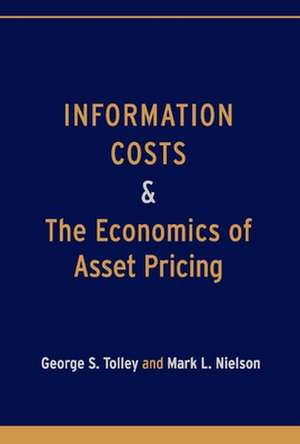Information Costs and the Economics of Asset Pricing
Autor George Tolley, Mark Nielsonen Limba Engleză Hardback – 14 feb 2021
Preț: 156.72 lei
Nou
Puncte Express: 235
Preț estimativ în valută:
29.99€ • 31.39$ • 24.96£
29.99€ • 31.39$ • 24.96£
Carte indisponibilă temporar
Doresc să fiu notificat când acest titlu va fi disponibil:
Se trimite...
Preluare comenzi: 021 569.72.76
Specificații
ISBN-13: 9780943893136
ISBN-10: 0943893135
Pagini: 104
Dimensiuni: 95 x 234 x 158 mm
Greutate: 0.32 kg
Editura: BOOKBABY
Colecția BookBaby
ISBN-10: 0943893135
Pagini: 104
Dimensiuni: 95 x 234 x 158 mm
Greutate: 0.32 kg
Editura: BOOKBABY
Colecția BookBaby
Notă biografică
Dr. Tolley is Professor Emeritus of Economics at the University of Chicago and is also President of RCF Economic & Financial Consulting, Inc. Dr. Tolley received a Ph.D. in Economics from the University of Chicago, an M.A. in Economics from the University of Chicago, and a B.S. in Economics from American University. Dr. Tolley's published works include 22 books and over 50 articles. Among the journal articles, eleven were published in: the American Economic Review, Econometrica, the Journal of Political Economy, and the Quarterly Journal of Economics. He has participated in the preparation of 25 monographs and technical studies, and over 80 chapters contributed to books, conference proceedings, and other research studies. Dr. Tolley has held executive positions in the Federal Government, including Deputy Assistant Secretary of the Treasury for Tax Policy and Director of the Economic Development Division of the Economic Research Service of the U.S. Department of Agriculture. Dr. Tolley was Director of the Center for Urban Studies at the University of Chicago from 1978 to 1985. He has held visiting professorships at Purdue University, the University of California at Berkeley, Nankai University, and Guelph University. Dr. Tolley is a Fellow of the American Association for the Advancement of Science (AAAS). He has served on committees of the National Research Council of the National Academy of Sciences. He is a founding editor and now honorary editor of the Elsevier professional journal Resources and Energy. He is the recipient of an Honorary Doctoral degree from North Carolina State University. He is the recipient of an honored colleague award of the Society for Benefit-Cost Analysis. Dr. Tolley has made important original academic contributions. He is a pioneer in the areas of Environmental, Urban, and Energy Economics. Among his accomplishments, Dr. Tolley long has been an internationally recognized leader in the development and application of techniques for measuring costs and values that are determined outside of conventional markets. He has applied these techniques to the valuation of environmental amenities and costs, urban housing, value of life and medical treatments, among others. He has used such estimates successfully in court cases and regulatory proceedings. This book grows out of his experience as Deputy Assistance Secretary of the Treasury. Dr. Nielson holds a doctorate from the Department of Economics of the University of Chicago, where he was an assistant to leading finance experts including Merton Miller, Victor Zarnowitz and Kenneth French. His experience includes teaching at the Stockholm School of Economics and colleges in the U.S. He has held positions at Morgan Stanley where he worked on asset allocation and corporate governance, at Arthur Anderson where he worked on economic damages, tort litigation and energy, and at RCF where he worked on derivative markets and market microstructure. Through the firm that he heads, MacroEconLLC, he has consulted with a variety of clients including the California Public Employees Retirement System (Calpers) as part of its target firm program, Central Bank of Sweden on the term structure of interest rates and Bankers Trust in New York City on investment banking, high-tech financing deals and derivatives trading. He has conducted economic forecasting for the Bank of England, the Federal Reserve Bank of Philadelphia, Bloomberg, and the Wall Street Journal. As an example of his versatility, he has consulted to U.S. senators and national political campaigns on political polling.
